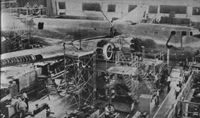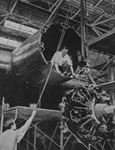
Flight, April 1940
WORLD'S LARGEST BOMBER
America's 210 ft. Span Giant
INFORMATION has been released by the U.S. War Department relating to the very large bomber, known as the B19, being built by the Douglas Aircraft Company at Santa Monica. Its gross weight of approximately 70 tons (157,000 lb.) will make it easily the largest aeroplane ever built, and with its wing span of 210ft. it should be an impressive sight. Its speed, with four engines totalling about 6,000 h.p., is given as 200 m.p.h. Its airscrews will be three-bladed constant-speed of 16 ft. diameter, and the undercarriage will be of the nosewheel type. The figure of 28 tons given for its disposable load (fuel, crew, and military load) is 40 per cent, of its loaded weight and is above the corresponding figure for commercial transports of latest design. The Lockheed Lodestar shows 33.7 and the Douglas DC3 a ratio of 32.7 per cent., which makes one a little sceptical of the 40 per cent, of the very much bigger B19. One is even more sceptical of its value as a military weapon, considering its very great cost and its very great vulnerability to gunfire. Its power loading of about 26 Ib./h.p. seems very high, and does not augur a good take-off and climb. One wonders if there is thought of refuelling in the air.
Some idea of the size of this giant bomber - the name is for once justified - can be obtained by comparing its dimensions with those of our biggest air liner, the Ensign, whose span is 123ft. and gross weight 48,500 lb. The Dornier DoX had a span of 157ft. and gross weight of 123,000 lb., with a power of 7,200 h.p. The contract for the construction of the B19 was signed some five years ago.
Описание:
- Flight, April 1940
WORLD'S LARGEST BOMBER - Flight, October 1940
LEVIATHAN BOMBER
Фотографии
-
Мировая Авиация 183
В 1935 году в авиакорпусе Армии США приступили к изучению вопроса о возможности разработки настоящего стратегического бомбардировщика. Работы велись под кодовым названием "Project D". Одним из результатов работы стал этот Douglas XB-19, выполнивший первый полет в 1941 году.
-
OS 1 / H.Cowin - X-Planes
The mammoth 212 feet wingspan sole Douglas XB-19, 38-741, holds a crowd of Douglas workers enthralled as it taxies away from its Santa Monica birthplace to depart for the nearby US Army Air Corps base at March Field on its 27 June 1941 first flight. Initiated at the US Army's behest in early 1935, the XB-19 was never intended to enter production; rather it was always destined to serve as a test bed to see just how far existing technology could be pushed. The biggest problem was lack of money, causing the planned debut of the XB-19 to slip by more than three years. Powered by four 2.000hp Wright R-3350-5s, the bomber's top level speed was 224mph at 15,700 feet, while the giant cruised at 135mph. These were not particularly impressive figures for 1941, but the 7,300 mile range with a 6.000lb bombload surely was.
-
Air Pictorial 1987-09
XB-19 38-471 taking off on its first flight. 27th June 1941. Largest aircraft of its time, it had 8-ft.-dia. mainwheels
-
Aeroplane Monthly 1991-12 / B.Gunston - A monster from Santa Monica
The 212ft-span XB-19 was first flown on June 27, 1941. The 55min flight was made from Clover Field, Santa Monica with Maj Stanley M. Ulmstead at the controls. This photograph may well show the aircraft shortly after taking off for the first time.
-
Air Pictorial 1987-09
Overall view of the Douglas XB-19, 38-471, in its original form, powered by 2,000-h.p. Wright Cyclone R-3350-5 radial engines. Maximum all-up weight was 162,000 lb.
-
Aeroplane Monthly 1991-12 / B.Gunston - A monster from Santa Monica
Another view of the XB-19 taken a few weeks before the first flight. In addition to the pilot, Maj Stanley Ulmstead, a crew of seven was carried on the maiden flight.
-
Aeroplane Monthly 1991-12 / B.Gunston - A monster from Santa Monica
Lt-Col James Taylor and Maj Stanley Ulmstead chatting at Clover Field just before the latter carried out the first flight of the XB-15.
-
Aeroplane Monthly 1991-12 / B.Gunston - A monster from Santa Monica
The same aircraft shortly before the first flight.
-
Aeroplane Monthly 1991-12 / B.Gunston - A monster from Santa Monica
The repainted XB-19 pictured at Wright Field early in 1942 following acceptance by the Air Corps in October 1941.
-
Air Pictorial 1987-09
In 1943 the aircraft was re-engined with 2,600-h.p. Allison V-3240-11 s, becoming the XB-19A. Top speed was then 265 m.p.h.
-
Aeroplane Monthly 1991-12 / B.Gunston - A monster from Santa Monica
The Douglas XB-19 nearing completion at Clover Field early in 1941. The first flight was originally scheduled for May 17 but had to be postponed while problems with engine backfiring, propeller-pitch control and braking were resolved.
-
Flight 1940-04 / Flight
The rear section of the fuselage of the Douglas B-19 bomber, under construction in the company's Santa Monica works. With a wing span of 210ft. and a gross weight of 70 tons, it will dwarf all other aircraft. The colossal proportions of the single fin may be seen, and the tailplane appears as large as the wing of many a transport aeroplane. There appears to be a circular turret opening in the top of the fuselage. Note the screens hung from the roof for secrecy.
-
Flight 1940-10 / Flight
Typically "Douglas" in shape, the tail unit is itself a tremendous structure. The elevator appears to be fabric-covered.
-
Flight 1940-04 / Flight
The working platforms which are being used for the construction of the vast wing of the Douglas B-19. Following usual modern procedure, the wing is being built in the vertical position, and its outline is shown superimposed on the photograph.
-
Flight 1940-10 / Flight
The wing was built in the vertical position on a specially constructed staging. Though the engine nacelles are of very large proportions, they are dwarfed by the wing.
-
Flight 1940-10 / Flight
DEMOCRACY'S SWORD AND ARMOUR: The wing and fuselage of the Douglas B-19 bomber join company in the factory at Santa Monica where this great aeroplane is under construction for the U.S. Army Air Corps. The hoses going in through the cockpit windows are probably for sucking out or delivering ventilating air.
-
Flight 1940-10 / Flight
Installing one of the 18-cylinder two-row Wright Duplex Cyclones, which have a take-off rating approximating 2,000 h.p. Attachment is by "dynamic mounting" to the cylinder heads at the nine points seen on the nacelle.
-
Aeroplane Monthly 1993-05 / D.Higgs - Haunting images
What appears to be a painting of a Douglas B-19 on a wall at Seething. First flown on June 27, 1941 as the XB-19, it was redesignated XB-19A and used during the war as a transport.
- Фотографии

















